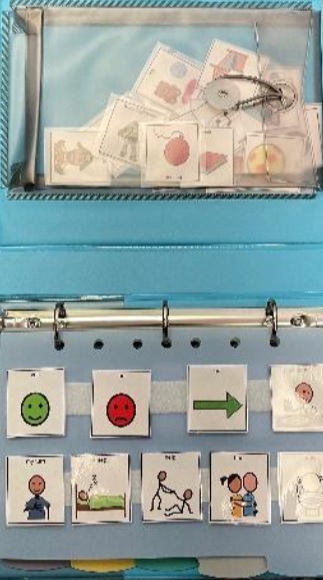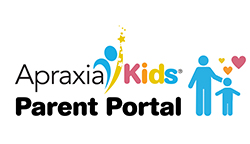A parent’s natural instinct is to automatically know what their child wants. Many parents don’t realize that they let their children get away with doing very little to get what they want. This is fine when a child’s speech is developing as expected, but when a child has a speech delay the parent must push the child to practice the skills being taught in therapy. Your speech therapist (SLP) will coach you on how to do this (ask for homework if you aren’t automatically receiving it). Here are some ideas to try:
- Use gestures to supplement speech attempts. It’s best if they are signs from sign language that you learn (Google a word + “sign language” to find out what the sign is), so that other people will understand them, too. But if the child or your family makes up a few of their own signs, that’s okay too. Make sure anybody your child spends time with knows what the signs/gestures mean. It’s important for other people to use them – while simultaneously talking – so that the child feels like doing so is normal.
- Low tech communication: Print pictures of your child’s favorite foods, toys, places, people. You can laminate them and put Velcro on them then stick them to another Velcro page on a wall or binder. This can become a “communication board” that your child can use to tell you what they want. (See picture below.) Again, be sure that you use them, as well (while simultaneously talking about what the picture shows), so that this will seem like a normal way to communicate within your household.
- High tech communication: a voice output application on a tablet. If you are starting very early in this process, you can start with the free version of GoTalk NOW. Consult with a speech therapist before purchasing a communication application. It is important to have an assessment to figure out the right application for your child. Yet again, others should use the device in conjunction with talking to demonstrate to the child that this is a normal way to communicate.
- “Communication temptations”: Put things on a higher shelf or in a container your child can’t open, “accidentally” forget to give them something they need (e.g., a fork at dinner time), etc.. Then your child will have to communicate to get what they need or want, in whatever way is possible at the time: a gesture, a vocalization, a sign, a picture, or a spoken word.
- If your child is able to copy some sounds you make, have them try to copy the word before getting what they want. The best way to do this is to give them choices. Pretend that you’re not sure what they want, and list two things (“Did you want a banana or an apple?”). Initially, it’s best to say the word they want second; it’s easier for them to copy the most recent word. Accept their best attempt, even if it’s only one sound. For example, if the child wants something open you can model the word “open”. Once they say their best attempt “ohhhh” you open it. Always be sure that you say the words correctly. Children have to hear correct words in order to learn to say them properly.
- Many of our children with speech delays use ‘behavior’ to communicate because they don’t yet have other ways to express themselves. This can look like yelling, pushing, hitting, or crying when they don’t want something. Make sure your child has a way to produce “power words” like “no,” “mine,” “all done,” “more,” and “mad.” For example, give your child an easy, clear way to say they don’t like/want something. You can use the sign for “all done” (shaking hands or bringing hands together and then separating them). You can have them wave “bye”. You can even teach them the classic single finger wave for “no”. If you can get some sounds, you can teach them to say “uh-uh” for no. Share these strategies with everyone else who interacts with the child.
- Incorporate easy emotional words into your daily routines whenever possible. These include words such as “uh-oh”, “wow”, “ooh”, “whee”, “aha,” and “whoa,”. These words are mostly made up of vowels and each one is associated with a strong melody that helps to express the idea even if the sounds are not clear. They also express strong emotions. Therefore, they can ease some of your child’s frustrations.
- Ask your therapist for a “word of the week”- a word that you will have your child practice saying every day.
- Read repetitive books (Brown Bear, Pete the Cat). Read the book every day for a week. Then, the next week, start pausing before the last word on the page and see if your child will fill it in (I love my white _____). Count to 5 in your head. If your child says something similar to “shoes”, cheer for your child and say “Yes! Shoes!” then keep going. If your child doesn’t say anything, you say “shoes” and keep going. When saying one word is easy then you can start having your child say the last two words. Don’t push them to say the word; just pause to provide the opportunity. Think of it as “inviting” instead of “requiring”.
- Bath time activities: Get some bath toys and have your child practice saying the names of the toys. Bathtub markers are great; you can draw pictures that match words that your child is practicing. Practice body part names, too.
- Mealtime is a great time to practice “eat”, “yum”, “yuck”, “like”, “gross”, food names, food groups, and so on. You can also practice repeating words as you set the table together: “Plate, plate, plate, plate. Fork, fork, fork, fork. Spoon, spoon, spoon, spoon.” (The same strategy works for sorting laundry.)
- In the car, sing repetitive songs (Old Macdonald, Wheels on the Bus). Play “I Spy”, making the level match your child’s abilities (say the names of objects, describe objects, etc.). Develop vocal routines related to your daily driving routes (“Red light, stop! Green light, go!”).
- My turn/your turn: Get the family involved in a game that makes your child have to practice “my turn” or “your turn” (or “you do it”/”I do it” if “your turn”/”my turn” is tricky). Don’t use unnatural sentences like “You do” although it’s okay to accept them if that’s your child’s best attempt. Remember that the child needs to hear correct English in order to learn to speak correctly.
- Play animals: Animal sounds – and other sound effects like truck noises – are a great way to increase your child’s confidence to try talking. They also give your child a chance to practice different syllable types (“baa” or “baabaa” for sheep, “moo” for cow, “wuhwuh” for dog barking).
- Learn the cues your SLP uses in therapy: they might do something with their hand or hold up a picture to give your child a hint. Use these at home, too.
- Don’t be afraid to come up with your own ways to help your child practice saying a word (read the sections about principles of motor learning and therapy/treatment to help guide you).
- In low-pressure situations, ask questions that make your child talk. Avoid questions that only need a short answer like yes/no or a single name (“what is this?”) unless this is your child’s goal. When looking at a book you can ask “What’s happening here?” or “Tell me the story!” or “What’s going to happen next?” and see what happens. Model back using longer sentences if your child only says one word (just one or two words more than what your child is saying). However, be careful not to put the child on the spot in a stressful situation (e.g., “Tell Grandma what you did at the zoo last week”).
- Wordless picture books are great for teaching your child to describe what he sees in a picture and to practice creating a story. You can start with a carrier phrase “I see ___” and then make it harder.
- Word practice: A common goal is to say a word 5 times before getting something. You can do ‘structured’ practice by having your child say a word 5 times before getting a reward (the object, a candy, a stamp, or whatever else motivates your child).
- Books for older children: Read a book with your child and have them find the words that have the sound they are working on, then practice it 3-5 times.
These are just a few ideas to get you going. Talk to your child’s SLP and go to the Apraxia Kids Facebook group for even more ideas. A lot of SLPs and parents have blogs/websites/Instagram pages that you can look at for ideas also!
Low tech communication board/book example

By Aubrie Hagopian, M.A., CCC-SLP
January, 2022
